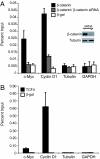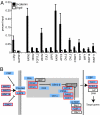Serial analysis of chromatin occupancy identifies beta-catenin target genes in colorectal carcinoma cells
- PMID: 17360646
- PMCID: PMC1805576
- DOI: 10.1073/pnas.0611576104
Serial analysis of chromatin occupancy identifies beta-catenin target genes in colorectal carcinoma cells
Abstract
Most instances of colorectal cancer are due to abnormalities in the Wnt signaling pathway, resulting in nuclear accumulation of beta-catenin. beta-Catenin activates transcription of target genes primarily by associating with the T cell factor/lymphoid enhancer-binding factor (TCF/Lef) family of transcription factors. In this report, we use serial analysis of chromatin occupancy (SACO) to identify 412 high-confidence beta-catenin targets in HCT116 colorectal carcinoma cells. Of these targets, 84% contained a consensus TCF motif and were occupied by TCF4 in vivo. Examination of the flanking 5-bp residues in each consensus revealed motif-specific enrichment at neighboring sites. beta-Catenin binding was localized to the 5' promoters, internal regions, and 3' UTRs of protein-coding genes. Furthermore, 15 components of the canonical Wnt pathway were identified as beta-catenin target genes, suggesting that feed-forward and feedback mechanisms exist to modulate the Wnt signal in colon cancer cells.
Conflict of interest statement
The authors declare no conflict of interest.
Figures




References
Publication types
MeSH terms
Substances
Grants and funding
LinkOut - more resources
Full Text Sources
Medical

